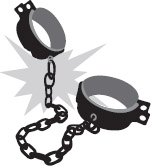Uncle John’s Bathroom Reader Zipper Accidents (34 page)
Read Uncle John’s Bathroom Reader Zipper Accidents Online
Authors: Uncle John’s

Shortly after passing the ground floor, the elevator car hit water. Tyler and Amaker were unaware that the city had been flooded by a storm that day—and that the hotel’s basement was now basically a pool. The elevator stopped working and sank to the bottom of the shaft. Water started leaking into the car. Worse: The two men were the only people working in the hotel that day. Luckily, they were able to reach 911 by cell phone. Unluckily, they didn’t know the hotel’s address. All they could tell the operator was the name of the streets at a nearby intersection. Then the phone connection cut off.
New York City firefighters were soon in a mad scramble to find the trapped men. They got to the intersection and—on nothing more than a hunch— went to the Staten Island Hotel. But the security guard told them nobody was in the building. The
firefighters persisted. They went to the rear of the building and saw a door that was ajar. They approached it…and heard screams. When they got to the car, Tyler and Amaker were standing on their supply cart, their heads three feet from the elevator’s roof—and water up to their necks. It had been more than an hour since they had called 911. The firefighters dropped a narrow ladder into the car through an emergency hatch on the car’s roof, and the trapped men were able to climb out of the car, their ordeal finally over.
Tyler and Amaker were taken to the firehouse, uninjured but badly shaken up. “They were happy to see us,” FDNY captain James Melvin told reporters. “I think they thought the end was near.” Asked why he and his men had chosen the hotel to check out first, Melvin answered with a shrug, “Lucky guess.”
No surprises:
A Norwegian man (unnamed in reports) found out that his surprise 40th birthday party was happening in a cabin in the woods in southern Norway. As the first of about 30 guests began to arrive, the birthday boy hid behind some trees near the house. He planned to surprise the friends who were there to surprise him: He took his shotgun and fired a round into the air. The first shot definitely surprised the partygoers. So did the second shot, which happened when the man emerged from his hiding spot, tripped, and accidentally fired. He shot one friend in the leg.
N
ice tip.
Dakoda Garren went to Rocky’s Pizza in Battle Ground, Washington, in August 2012, and paid for his meal with coins, including a quarter—a 1930s Liberty Head quarter worth about $18,500. According to police, Garren had stolen the coin, along with several others, months earlier, and was spending them around town at face value, having no idea of their real worth. Garren was arrested on a charge of first-degree theft.


Unamused.
Larry Jones bought an order of French fries at Darien Lake Theme Park in New York in September 2012, paying for it with a $50 bill. The cashier didn’t like the look of the bill and called security. When they questioned Jones about the money, he showed them roughly $1,200 worth of $50 bills that he said he got as payment for a remodeling job he’d done. Then he stuffed a bunch of them into his mouth and tried to swallow them. Security officers were able to stop him. Jones was charged with possession of a forged instrument and tampering with physical evidence.
Cooking the books.
In July 2012, a man in Sydney, Australia, sold his Toyota Supra for $15,000 in cash. He hid the cash in his oven “because his
wife never used it.” Sometime later his wife came home…and turned on the oven. (She was going to cook some chicken nuggets for their two children.) Australian bills are made from a plastic polymer, so the stacks of bills melted into lumps. Worse: The man had meant to use the cash the next day to make a mortgage payment—the couple was already behind on their payments—but the bills were so damaged that the bank wouldn’t accept them. “It was everything I had,” said the man, who was too embarrassed to have his identity made public.
Socked away.
Dana Leland bought a pair of socks at a Rhode Island Target in November 2012 and paid for them with a $100 bill. The bill was counterfeit—and it was not exactly professionally made: It had Abraham Lincoln’s face on it. (Real $100 bills carry Ben Franklin’s face.) Police said Leland had gone into the same store three days in a row, buying items that cost less than $25 and paying for them with the Abraham Lincoln $100 bills. He was arrested.


Blank check.
Leah Jarolimek was arrested at a gas station in Sheboygan, Wisconsin, in 2006, for trying to buy potato chips and cigarettes with what the clerk suspected was a counterfeit $20 bill. The tip-off? While the front looked like a normal bill, the back was totally blank. Jarolimek protested, claiming she had no idea the bill was bogus.
P
hilippe Quint
is a Grammy-nominated classical concert violinist who routinely plays at such vaunted venues as Carnegie Hall and Lincoln Center. In 2008 he played a concert in Dallas, and after flying home he took a cab from the Newark Airport to his house. Unfortunately, he left something behind in the taxi: his violin. His $4 million, circa-1723 Stradivarius violin. Usually, when things get left in the back of a cab, they’re gone forever, but amazingly, Quint’s extremely valuable violin was tracked down by Newark police in just a few hours. Quint gave his cabbie, Mohammed Khalil, a $100 tip, and played an impromptu concert for about 50 drivers in the Newark Airport’s taxi holding area.
The Stradivarius
is synonymous with “priceless violin,” but there are other great violin makes out there, such as Goffriller, made in Venice in the late 17th century. Robert Napier of Wiltshire, England, owned one with his four siblings, who inherited it from their mother, who played it during World War II as a member of a troop entertainment troupe called the Ebsworth Quartet. In 2008 Napier took the violin to a dealer in London, who appraised the instrument at £180,000 (about $280,000). Napier took the train back home, and after getting off at Taunton Station, he realized he no longer had the
violin with him—he’d left it in the luggage rack by his seat. Despite a £10,000 reward and lots of press coverage, the violin never materialized.
Yo-Yo Ma
is probably the most famous cellist in the world (go ahead, name another one). But even he isn’t above losing a stringed instrument, even one as huge as a cello. In 1999 Ma took a cab to New York’s Peninsula Hotel to prepare for a concert in Brooklyn. He put his cello in the cab’s trunk, and when he arrived…he left it in the cab. The instrument was made in Venice in the 1730s and valued at about $2.5 million. Amazingly, police and Taxi and Limousine Commission workers found the instrument in a little over three hours—just in time for Ma to play his concert.
David Garrett
is a classical violinist with pop music leanings—he has celebrity good looks (fans call him “the David Beckham of the violin”) and he likes to do covers of Nirvana, Coldplay, and Michael Jackson songs in his stage shows, which are frequently broadcast on PBS. As one of the wealthiest and most notable violinists in the world, Garrett can afford to use only the best instruments, such as a Guadagnini. He had one until 2008. At the end of a concert at the Barbican Centre in London, he finished playing, went to walk off the stage, and tripped…falling onto his 236-year old, $1.2 million instrument.
COULD
A WOODCHUCK CHUCK?
T
he Abenaki Indians of what is now New England considered the woodchuck their maternal ancestor, “a wise grandmother who taught them to fish, hunt, and build canoes,” according to nature writer Sy Montgomery. The beloved—and relatively rare—rodents generally kept to the woods. But when white settlers arrived, they cleared the woods, killed the woodchuck’s predators, and planted crops that happened to be the kinds of foods that woodchucks, also known as groundhogs, loved to eat.


Suddenly, woodchuck populations exploded and the little guys that once seemed so wise and cute now seemed a bit less of both. This is
not entirely surprising; animals that eat and dig as much as a woodchuck don’t often make friends among farmers. Soon enough, pretty much everyone in New England agreed that woodchucks were awful and far, far too plentiful. In 1883 the New Hampshire Legislative Woodchuck Committee declared the woodchuck “absolutely destitute of any interesting qualities.” As a result of the committee’s thorough investigation, the legislature moved to offer a bounty for each dead woodchuck the citizens of the state could procure.
